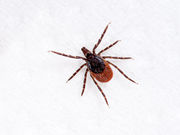Worse facial function outcomes for patients with Lyme disease-associated facial palsy
MONDAY, Sept. 12, 2016 (HealthDay News) — For patients with Lyme disease-associated facial palsy (LDFP), corticosteroid use is associated with worse long-term facial function outcome, according to a study published online Sept. 6 in The Laryngoscope.
Nate Jowett, M.D., from Massachusetts Eye and Ear and Harvard Medical School in Boston, and colleagues conducted a retrospective cohort study involving all patients with a prior diagnosis of unilateral LDFP who presented between 2002 and 2015. Static, dynamic, and synkinesis parameters of facial functions were graded by two blinded experts for 51 patients.
The researchers found that patients who received dual therapy with antibiotics and corticosteroids and triple therapy with antibiotics, corticosteroids, and antivirals had significantly worse facial outcomes than those who received antibiotic monotherapy; this was most pronounced among those who were assessed 12 months or later following LDFP onset.
“An association between corticosteroid use in acute LDFP and worse long-term facial function outcomes has been demonstrated,” the authors write. “Care should be taken in differentiating viral or idiopathic facial palsy (e.g., Bell palsy) from LDFP.”
Copyright © 2016 HealthDay. All rights reserved.








